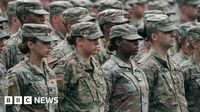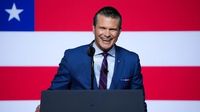On Tuesday, September 30, 2025, Secretary of Defense Pete Hegseth delivered a fiery and controversial address at Marine Corps Base Quantico, Virginia, unveiling sweeping changes to the U.S. military’s physical fitness standards. The new rules, which will be enforced across all branches except the Coast Guard, have sparked immediate debate among service members, lawmakers, and the public, raising questions about readiness, fairness, and the future of diversity in the armed forces.
Hegseth’s speech, delivered to a packed room of America’s top generals and admirals, left little room for ambiguity. “It’s tiring to look out at combat formations, or really any formation, and see fat troops,” he declared, as reported by ABC News. “Likewise, it’s completely unacceptable to see fat generals and admirals in the halls of the Pentagon and leading commands around the country and the world. It’s a bad look. It is bad, and it’s not who we are.” He made it clear that the era of what he called “politically correct, overly sensitive, don’t-hurt-anyone’s-feelings leadership” was over, inviting any leaders who disagreed to “do the honorable thing and resign.”
Under the new directive, all active-duty personnel must engage in daily physical training, enforced by their commanders. At least twice a year, every service member will undergo a fitness test that, for the first time, requires everyone—men and women alike—to meet a “male standard” adjusted only by age. The annual service test now demands a passing grade of 70 percent, and a new body composition standard, based on the height-waist circumference method, will be evaluated twice a year. Personnel exceeding these limits will be placed in remedial programs and, if they fail to improve, could face separation from service.
The changes are part of what Hegseth described as a broader push to “toughen up the force” and align with President Trump’s order to “de-woke the military,” according to The New York Post. Hegseth was explicit in his rejection of recent diversity, equity, and inclusion (DEI) initiatives, stating, “No more identity months, DEI offices, dudes in dresses, no more climate change worship, no more division, distraction or gender delusion, no more debris. I’ve said before and will say again, we are done with that s—.”
Hegseth’s memo further stipulates that troops assigned to combat roles must undertake a combat field test—wearing full equipment—at least once per year, while those in non-combat positions will complete a combat readiness test that can be administered in any environment. National Guard and Reserve members are also now required to take at least one fitness test annually.
The new standards mark a sharp departure from existing policies, which varied by branch and often included gender-normed benchmarks. For instance, the Army’s recently introduced Army Fitness Test (AFT) assesses soldiers through five events: a three-rep max deadlift, maximum hand-release push-ups in two minutes, a plank hold, a two-mile run, and a sprint-drag-carry. Soldiers must score at least 60 points in each event for a total minimum of 300 points. The Air Force, starting in March 2026, will score service members on body composition and several endurance and strength exercises, including a mandatory two-mile run. The Navy and Marine Corps have their own rigorous tests, with the Marine Corps’ Combat Fitness Test featuring an 880-yard sprint in boots, repeated overhead lifts, and a simulated battlefield course. The Coast Guard, not subject to Hegseth’s rules, uses a simpler pass-fail test including push-ups, sit-ups, a 1.5-mile run, and a flexibility assessment.
Perhaps the most contentious change is the introduction of gender-neutral standards for all combat roles. Hegseth acknowledged the likely impact on female service members, stating bluntly, “If women can make it, excellent. If not, it is what it is. It will also mean that weak men won’t qualify—because we’re not playing games. This is combat. This is life or death.” According to ABC News, beginning in 2026, both male and female soldiers will be required to meet identical physical performance benchmarks relevant to the demands of the battlefield.
These remarks and policies have drawn sharp criticism from various quarters. Representative Mikie Sherrill (D-N.J.), a former Navy pilot and current gubernatorial candidate, accused Hegseth of trying to force women out of the military. “Eliminating the current highly rigorous standards for women in combat positions has nothing to do with increasing lethality and everything to do with forcing women out of the Armed Services,” Sherrill said in a statement following the announcement, as reported by Nexstar Media. She continued, “Secretary Hegseth has said he does not believe women should serve in combat. Now he is trying to make that happen by escalating his war on women in the military, despite presenting no evidence that women cannot ably serve in combat positions.”
Sherrill also characterized the Quantico event, where President Trump delivered remarks alongside Hegseth, as a “vanity rally” and “yet another display of incompetence.” She argued, “Serving in the military is a serious business for serious people. Today’s campaign rally is just the latest example of how Secretary Hegseth is incapable of doing his job and has to resort to theatrics to distract from his failures.” She warned that the administration’s focus on “partisan, culture war ideologies” would ultimately make the military less safe and less effective.
Hegseth, for his part, defended his approach as necessary for restoring a “warrior ethos” and merit-based leadership. He accused previous military leaders of being promoted for their identities rather than their abilities, and asserted, “The era of politically correct, overly sensitive, don’t-hurt-anyone’s-feelings leadership ends right now at every level.” He went so far as to invite dissenting officers to resign and has already dismissed several high-ranking leaders, including former Chairman of the Joint Chiefs of Staff C.Q. Brown and former Chief of Naval Operations Adm. Lisa Franchetti, both of whom he accused of advancing diversity over merit.
Hegseth’s unapologetic stance extended to his views on military culture. “Those officers were following elected political leadership, an entire generation of generals and admirals were told that they must parrot the insane fallacy that, quote, ‘our diversity is our strength,’” he said. “Of course, we know our unity is our strength.” He emphasized that his role was to distinguish between those who merely followed civilian orders and those who actively embraced what he called the “Woke Department.”
As the military prepares to implement these new standards in 2026, the debate over the balance between readiness, merit, and inclusion is sure to intensify. While Hegseth’s supporters argue that a return to strict, uniform standards is essential for combat effectiveness, critics warn that the changes risk undermining the military’s diversity and morale. The coming years will reveal whether Hegseth’s vision delivers a stronger fighting force—or sows deeper divisions within its ranks.


